One blog stated the objective clearly in a recent headline: Coronavirus May Mean Automation Is Coming Sooner Than We Thought, SingularityHub.com, March [...]]]>
One blog stated the objective clearly in a recent headline: Coronavirus May Mean Automation Is Coming Sooner Than We Thought, SingularityHub.com, March 19, 2020:
. . .Peter Xing, a keynote speaker and writer on emerging technologies and associate director in technology and growth initiatives at KPMG, would agree. Xing believes the coronavirus epidemic is presenting us with ample opportunities for increased automation and remote delivery of goods and services. “The upside right now is the burgeoning platform of the digital transformation ecosystem,” he said. . . .
Indeed, some quarters see the epidemic as a swell opportunity to switch to automation and away from annoying human workers who demand paychecks and lunch breaks.
Some industries, like automotive manufacturing (shown below), already have machine-only areas of production.
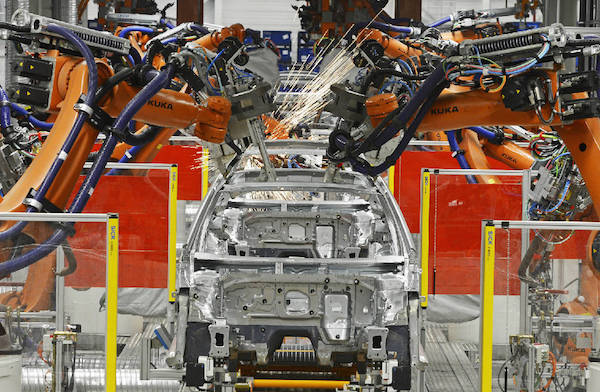
In China, businesses see an immediate need for service robots as well as more automation in factories:
]]>Robots rising: Coronavirus drives up demand for non-human labour in China, Reuters, March 20, 2020
SHANGHAI, March 20 (Reuters) – A shortage of workers and restrictions on human contact because of the coronavirus pandemic is driving up demand for service robots in China, potentially boosting a sector that has struggled to scale up commercially.
Venture capitalists with expertise in the robotics sector said they are anticipating orders from China to rise significantly this year, based on interest since the end of January when the virus began spreading in China.
That could take the use of service robots from novelties that deliver food and drink in restaurants and hotels to an army that performs essential functions in hospitals bound by strict no-contact rules.
“The healthcare segment has been really hot,” said Emil Jensen, vice president of China sales for Denmark-based Mobile Industrial Robots, which makes customisable robots that are used both in hospitals and on factory floors. [. . .]
FACTORY AUTOMATION
Along with the service robots, the coronavirus pandemic could spur demand for more automation at factories.
Many Chinese semiconductor plants located in the virus epicentre of Wuhan have run continuously throughout the outbreak, which chip industry experts attribute to their highly automated production processes.
Still, the virus itself also presents an obstacle to widespread long-term adoption of automation because of the economic stress it is imposing on many companies.
Huan Liu of Mujin, which makes intelligent robot sorting and picking systems, said companies often must spend millions of dollars for a basic automation project, which can take six to twelve months to complete.
“For new customers, it depends on which factor is stronger,” said Liu. “The need to replace labour during the virus, or the need to balance the budget as sales go down during the virus.”
Below, some types of manufacturing have largely become automated.
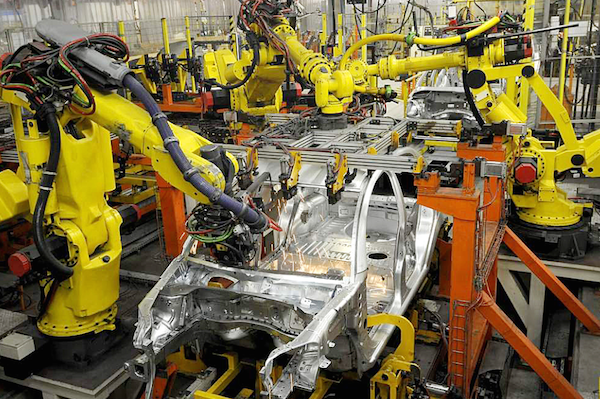
Keep in mind that tech experts forecast a massive loss of employment in the near future caused by robots and software. Oxford researchers forecast in 2013 that nearly half of American jobs were vulnerable to machine or software replacement within 20 years. Rice University computer scientist Moshe Vardi believes that in 30 years humans will become largely obsolete, and world joblessness will reach 50 percent. The Gartner tech advising company believes that one-third of jobs will be done by machines by 2025. The consultancy firm PwC published a report last year that forecast robots could take 38 percent of US jobs by 2030. In November 2017, the McKinsey Global Institute reported that automation “could displace up to 800 million workers — 30 percent of the global workforce — by 2030.” Forrester Research estimates that robots and artificial intelligence could eliminate nearly 25 million jobs in the United States over the next decade, but it should create nearly 15 million positions, resulting in a loss of 10 million US jobs. Kai-Fu Lee, the venture capitalist and author of AI Superpowers: China, Silicon Valley, and the New World Order, forecast on CBS’ Sixty Minutes about automation and artificial intelligence: “in 15 years, that’s going to displace about 40 percent of the jobs in the world.” A February 2018 paper from Bain & Company, Labor 2030, predicted, “By the end of the 2020s, automation may eliminate 20% to 25% of current jobs.”
It’s nice to see someone in the capitol paying attention to this world-changing subject. This bill won’t go anywhere, but increasing attention directed toward the coming jobs depression is absolutely welcome.
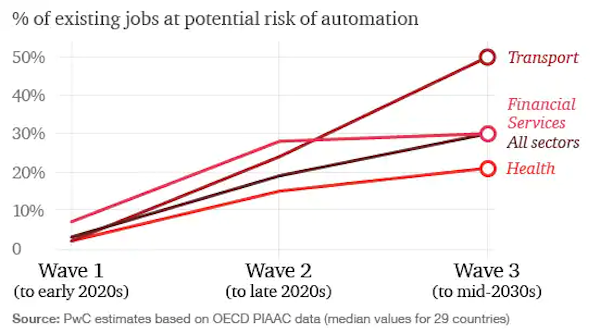
Next, some legislator can propose a bill to end low-skilled immigration entirely, because simple repetitive jobs will be taken by smart machines as soon as they are cheaper than humans.
]]>Sen. Sherrod Brown introduces measure to aid workers displaced by automation, Cleveland.com, September 11, 2019
WASHINGTON, D.C. – Ohio Democratic Sen. Sherrod Brown, who made “Dignity of Work” his slogan during a short-lived presidential exploration, on Wednesday introduced a bill that would require that workers get advance notice and training when their companies adopt new technologies.
The bill also would require that employers give six months of severance pay to workers whose jobs are lost to automation.
“No matter how technology changes, Ohio companies still need human beings to oversee that technology,” Brown told reporters. “Ohio workers will always be our greatest resource, but right now, too many workers get left behind when companies adopt new technology.”
Brown said his “Workers’ Right to Training Act” would require employers to provide and pay for on-the-job training for workers affected by the introduction of new technologies, including training those whose jobs are to be eliminated so they can get a similar job elsewhere.
By helping those workers receive the training they need, Brown said the bill will also help ensure the U.S. workforce remains high-skilled and capable of competing in a global economy, and ensure that workplace technology introductions are fair to workers. He said workers would have the right to sue if their employers don’t comply. (Continues)
Now the holiday sales statistics are in, and the system is working well: there were more [...]]]>
Now the holiday sales statistics are in, and the system is working well: there were more items ordered and shipped worldwide than ever before — with fewer human workers.
It has long been a talking point among businesses going big on automation that they were adding the machines to “help” human workers, not replace them. Of course it make no sense for a business to invest heavily in modern robotics just to make work easier for the humans — the long term plan is large scale replacement, such as has taken place in automotive manufacturing.
Below, humans have largely disappeared from some aspects of building cars.
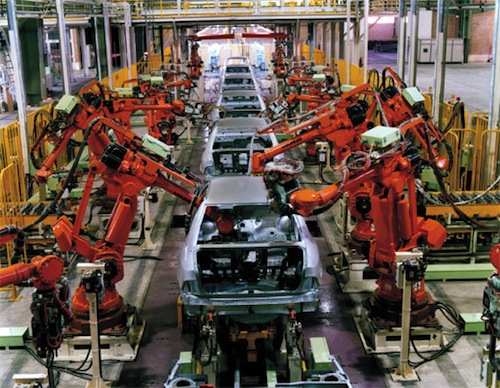
The jobs economy is booming now — thanks to Trump’s economic policies — but when machines become cheaper than human workers, replacement will happen. Amazon is a leading indicator of robotic trends, which we should watch closely.
Finally, it goes without saying that low-skilled immigrants are totally obsolete in the future automation economy.
]]>The Biggest Sign Yet That Automation Is Taking Over at Amazon, By Brian Merchant, Gizmodo, January 3, 2019
The day after Christmas, Amazon celebrated its own annual holiday tradition: announcing record-breaking sales in a very long press release that affirms its status as the largest retailer in the known universe. As such, Jeff Bezos’s Big Store said that in 2018, it surpassed its own sales records with “More Items Ordered Worldwide Than Ever Before.” Of course, Amazon announces some version of that milestone just about every year, as it continues to upend brick-and-mortar stores and march into new digital markets around the globe.
What is notable, though, is that this time, Amazon hit its record with fewer seasonal employees than, yes, ever before. As Alison Griswold reported in Quartz at the beginning of the holiday hiring season, Amazon brought on 20,000 fewer part-time workers than in 2017 or 2016. And it still managed to moved more products than any time in its history. More items shipping, fewer people shipping them—the equation’s pretty clear. Amazon’s embrace of automation is beginning to show itself, and it’s beginning to bear fruit for Bezos and co.
Amazon bought Kiva Systems, a company that built warehouse robots, back in 2012, and has long been integrating automation into its supply chain. It is experimenting with autonomous delivery vehicles. Last year, Amazon expanded its cashier-less grocery store chain. And Amazon has pursued more fantastical autonomous visions, from its ever-ephemeral delivery drones to robot-proof worker cages employees might use to navigate a heavily autonomous environment. It even automates its top-tier white collar jobs.
But it’s only now that it looks like the company’s initiatives are poised to seriously impact hiring—the company had been expanding and growing at such a rapid clip (sometimes upwards of 40 percent revenue per quarter) and so had been hiring (especially in its fulfillment centers) like crazy too. There was room for both, and Amazon, ever sensitive to claims that it is automating jobs away, stressed that its robotics augmented work, not eliminate it.
In September 2017, the New York Times ran a short documentary about Amazon’s palletizer robots, which the company claimed had not led to any job cuts. “Amazon has preserved job growth at its factories so far,” the Times wrote. “Whether it can continue to do so is a subject of debate.” A year later, the answer seems to be that it will not. With the company’s growth rates currently expected to slow and to settle in the 20-30 percent range, and its automation technology maturing, the smart money says we’ll see it chip into job availability.
“We’ve seen an acceleration in the use of robots within their fulfillment centers, and that has corresponded with fewer and fewer workers that they’re hiring around the holidays,” Citi analyst Mark May told CNBC last November. This was, he said, the “first time on record” that Amazon planned to hire fewer holiday workers than it did the previous year, in the company’s 20-year lifespan. (Continues)
Below, a 2015 map of [...]]]>
Below, a 2015 map of employment in the US from National Public Radio (NPR) shows the most common occupation in every state, where truck driving now predominates.
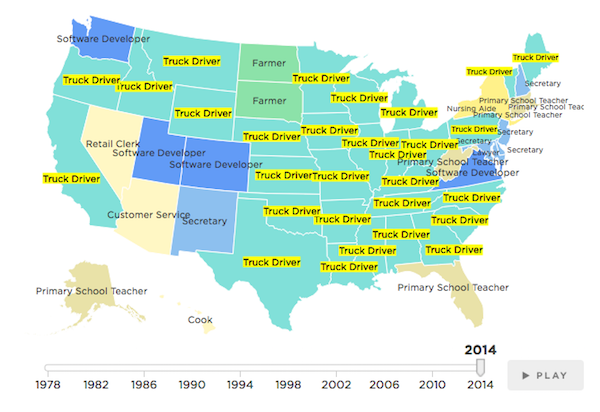
It’s interesting to look at NPR’s chart of “Common Jobs” that accompanies the map above: in 1978, for example, Secretary was a top employment category, but office technology has already reduced the number of persons in that job with more reductions to come.
It would be nice if official Washington were paying attention to the fundamental economic changes coming our way from the automation wave. There’s not a whole lot that can be done, since machines will be utilized whenever they become cheaper than humans. Still, an emphasis on appropriate technical training would help, and of course we needn’t be importing foreign workers when nearly half of Americans will be made jobless in 20 years if the forecast of Oxford researchers is correct. Therefore:
Automation Makes Immigration Obsolete
The Christian Science Monitor looked at the technology largely from the viewpoint of the drivers who will be affected, which is a pleasant change from the Silicon Valley opinion that any tech advance is totally cool, no matter the human consequences.

]]>Self-driving trucks in US offer window into where machines may replace humans, Christian Science Monitor, November 14, 2018
POMPANO BEACH, FLA. — On a muggy morning, Matt Brauneck noses his semi with its 53-foot trailer out of the yard, past the puddles left by a tropical storm. From his driver’s seat in the cab he has a clear view of the road and of the light suburban traffic leading to Interstate 75 in southeastern Florida. Atop the pearly-white cab are six cameras and three radar sensors that are feeding data to a computer stack behind Mr. Brauneck’s seat and to a remote operating base in Jacksonville, Fla., 300 miles away. Brauneck’s boss, Stefan Seltz-Axmacher, the head of a small robotics company, is wedged in the back. I’m sitting up front.
And we’re about to turn over command of 16 tons of aluminum and steel to an algorithm.
After the truck eases onto the highway, Brauneck talks into his headset to the technicians in Jacksonville. Ten minutes later he gets the all-clear: Time to engage automation. He turns a cracker-sized red knob on the dashboard and flicks a switch. “We’re rolling. It’s on,” he says.
Brauneck lifts his hands from the wheel, which jerks occasionally to correct our path. The accelerator pedal at his feet is working itself up and down, or so it seems, as we cruise along I-75. Brauneck says the first time he “drove” a truck in automation it felt like the first time he scuba dived. Like breathing underwater, “it didn’t feel right,” he says. Now it’s routine for him.
Yet it’s not routine for me. I can’t stop watching the twitching wheel. Outside, the narrow highway shoulder is hemmed by a 10-foot fence to keep out alligators from the surrounding swampland. I see vultures wheeling overhead – seriously.
Welcome to tomorrow on the nation’s highways. Your local truck stop is one of the latest places where machines may soon replace jobs now done by humans.
For decades, robotic devices have been remaking the world of work, principally on the factory floor. They build our cars. They fetch our TVs and toasters in massive consumer warehouses. They weld the turbines used in jet engines.
But with advances in artificial intelligence, machines are poised to invade workplaces that once seemed immune to automation. A 2013 study by Oxford University found that fully 47 percent of jobs in the United States were at risk of being automated based on existing AI and robotics capabilities.
Transportation is one of the key areas where machines are on the march. People are both captivated – and frightened – by the prospect of self-driving cars pulsing through the nation’s streets. But for all the hype about automated cars, trucks may well begin hauling freight along highways, without the grizzled trucker at the wheel, first. Highway driving is more straightforward to automate than unpredictable urban driving and holds the promise of lower fuel costs, higher productivity, and improved safety.
Automated trucking is already a reality in remote mines and logging camps, and the US military has built its own robo-trucks to deploy in war zones. Volvo recently unveiled a prototype of an electric self-driving truck that doesn’t even have a cab for a driver.
While all this represents progress to many people, others worry about a looming loss of jobs. Andrew Yang, an entrepreneur and author of a book on automation, says AI could replace millions of semi-skilled humans in industries from fast food to retail. No job is immune, not even in white-collar fields such as accounting, insurance, and pharmacology.
“People talk about this as if it’s speculative and in the future, and we’re in the midst of it,” says Mr. Yang.
That warning may be premature – or prescient. What can the trucking industry tell us? (Continues)